Comprehensive Health History and Management of Mr. Porter's Case
VerifiedAdded on 2021/05/31
|20
|5070
|26
Case Study
AI Summary
This case study presents Mr. Porter, a 59-year-old male, and details his comprehensive health history, chief complaints of chest pain and shortness of breath, and current medical condition. The case includes an analysis of his past medical history, including a previous myocardial infarction, type 2 diabetes, and hypertension. The review of systems focuses on the cardiovascular and respiratory systems, highlighting findings such as ventricular tachycardia and elevated troponin levels. The current management plan includes prolonged bed rest, medication administration (aspirin, glyceryl trinitrate), and patient education. The case also provides a detailed medication profile, discussing the indications, mechanisms of action, pharmacokinetics, iatrogenic diseases, and contraindications of metoprolol, clopidogrel, cilazapril, glyceryl trinitrate, metformin, and gliclazide. The study also considers the impact of chronic kidney and liver impairment on drug metabolism and efficacy. This detailed analysis is crucial for nursing students to understand patient assessment, diagnosis, and management strategies in a real-world clinical scenario.

Nursing
Students name:
Institutional Name:
Students name:
Institutional Name:
Paraphrase This Document
Need a fresh take? Get an instant paraphrase of this document with our AI Paraphraser
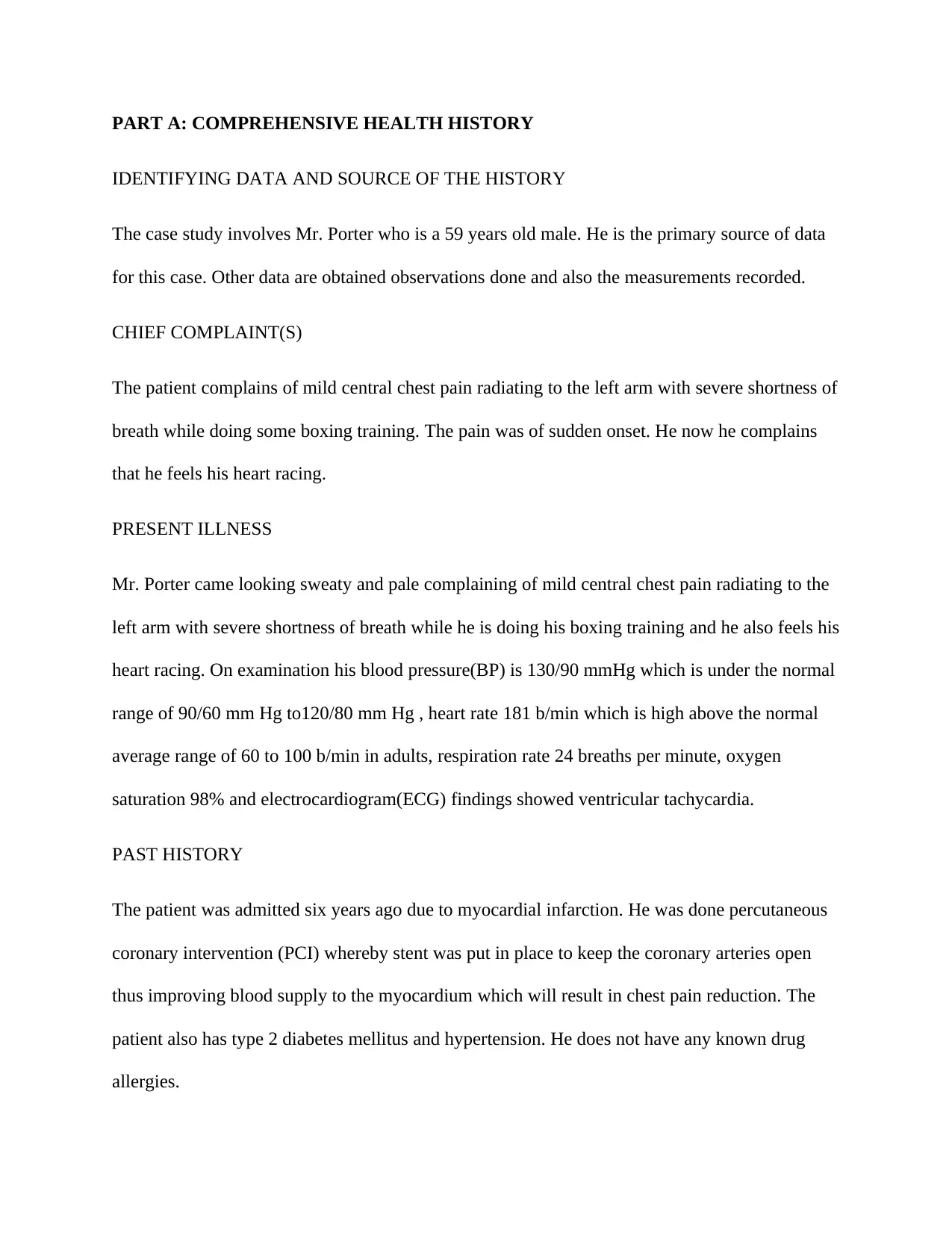
PART A: COMPREHENSIVE HEALTH HISTORY
IDENTIFYING DATA AND SOURCE OF THE HISTORY
The case study involves Mr. Porter who is a 59 years old male. He is the primary source of data
for this case. Other data are obtained observations done and also the measurements recorded.
CHIEF COMPLAINT(S)
The patient complains of mild central chest pain radiating to the left arm with severe shortness of
breath while doing some boxing training. The pain was of sudden onset. He now he complains
that he feels his heart racing.
PRESENT ILLNESS
Mr. Porter came looking sweaty and pale complaining of mild central chest pain radiating to the
left arm with severe shortness of breath while he is doing his boxing training and he also feels his
heart racing. On examination his blood pressure(BP) is 130/90 mmHg which is under the normal
range of 90/60 mm Hg to120/80 mm Hg , heart rate 181 b/min which is high above the normal
average range of 60 to 100 b/min in adults, respiration rate 24 breaths per minute, oxygen
saturation 98% and electrocardiogram(ECG) findings showed ventricular tachycardia.
PAST HISTORY
The patient was admitted six years ago due to myocardial infarction. He was done percutaneous
coronary intervention (PCI) whereby stent was put in place to keep the coronary arteries open
thus improving blood supply to the myocardium which will result in chest pain reduction. The
patient also has type 2 diabetes mellitus and hypertension. He does not have any known drug
allergies.
IDENTIFYING DATA AND SOURCE OF THE HISTORY
The case study involves Mr. Porter who is a 59 years old male. He is the primary source of data
for this case. Other data are obtained observations done and also the measurements recorded.
CHIEF COMPLAINT(S)
The patient complains of mild central chest pain radiating to the left arm with severe shortness of
breath while doing some boxing training. The pain was of sudden onset. He now he complains
that he feels his heart racing.
PRESENT ILLNESS
Mr. Porter came looking sweaty and pale complaining of mild central chest pain radiating to the
left arm with severe shortness of breath while he is doing his boxing training and he also feels his
heart racing. On examination his blood pressure(BP) is 130/90 mmHg which is under the normal
range of 90/60 mm Hg to120/80 mm Hg , heart rate 181 b/min which is high above the normal
average range of 60 to 100 b/min in adults, respiration rate 24 breaths per minute, oxygen
saturation 98% and electrocardiogram(ECG) findings showed ventricular tachycardia.
PAST HISTORY
The patient was admitted six years ago due to myocardial infarction. He was done percutaneous
coronary intervention (PCI) whereby stent was put in place to keep the coronary arteries open
thus improving blood supply to the myocardium which will result in chest pain reduction. The
patient also has type 2 diabetes mellitus and hypertension. He does not have any known drug
allergies.
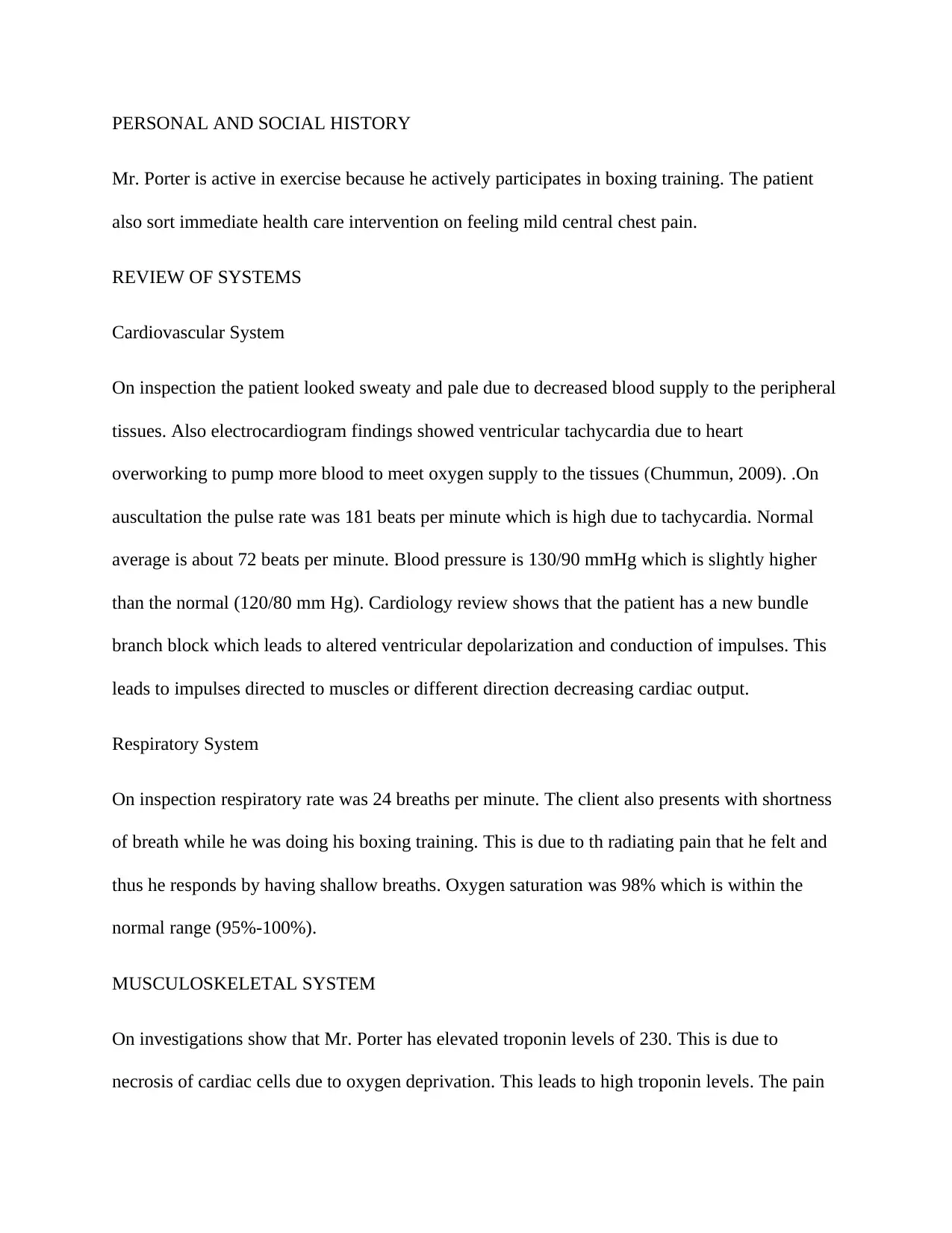
PERSONAL AND SOCIAL HISTORY
Mr. Porter is active in exercise because he actively participates in boxing training. The patient
also sort immediate health care intervention on feeling mild central chest pain.
REVIEW OF SYSTEMS
Cardiovascular System
On inspection the patient looked sweaty and pale due to decreased blood supply to the peripheral
tissues. Also electrocardiogram findings showed ventricular tachycardia due to heart
overworking to pump more blood to meet oxygen supply to the tissues (Chummun, 2009). .On
auscultation the pulse rate was 181 beats per minute which is high due to tachycardia. Normal
average is about 72 beats per minute. Blood pressure is 130/90 mmHg which is slightly higher
than the normal (120/80 mm Hg). Cardiology review shows that the patient has a new bundle
branch block which leads to altered ventricular depolarization and conduction of impulses. This
leads to impulses directed to muscles or different direction decreasing cardiac output.
Respiratory System
On inspection respiratory rate was 24 breaths per minute. The client also presents with shortness
of breath while he was doing his boxing training. This is due to th radiating pain that he felt and
thus he responds by having shallow breaths. Oxygen saturation was 98% which is within the
normal range (95%-100%).
MUSCULOSKELETAL SYSTEM
On investigations show that Mr. Porter has elevated troponin levels of 230. This is due to
necrosis of cardiac cells due to oxygen deprivation. This leads to high troponin levels. The pain
Mr. Porter is active in exercise because he actively participates in boxing training. The patient
also sort immediate health care intervention on feeling mild central chest pain.
REVIEW OF SYSTEMS
Cardiovascular System
On inspection the patient looked sweaty and pale due to decreased blood supply to the peripheral
tissues. Also electrocardiogram findings showed ventricular tachycardia due to heart
overworking to pump more blood to meet oxygen supply to the tissues (Chummun, 2009). .On
auscultation the pulse rate was 181 beats per minute which is high due to tachycardia. Normal
average is about 72 beats per minute. Blood pressure is 130/90 mmHg which is slightly higher
than the normal (120/80 mm Hg). Cardiology review shows that the patient has a new bundle
branch block which leads to altered ventricular depolarization and conduction of impulses. This
leads to impulses directed to muscles or different direction decreasing cardiac output.
Respiratory System
On inspection respiratory rate was 24 breaths per minute. The client also presents with shortness
of breath while he was doing his boxing training. This is due to th radiating pain that he felt and
thus he responds by having shallow breaths. Oxygen saturation was 98% which is within the
normal range (95%-100%).
MUSCULOSKELETAL SYSTEM
On investigations show that Mr. Porter has elevated troponin levels of 230. This is due to
necrosis of cardiac cells due to oxygen deprivation. This leads to high troponin levels. The pain
⊘ This is a preview!⊘
Do you want full access?
Subscribe today to unlock all pages.

Trusted by 1+ million students worldwide

also radiates to the left arm and this in turn interferes with functioning of the arm hence his daily
activities impaired.
CURRENT MANAGEMENT PLAN
Mr. Porter has to be under prolonged bed rest so that the pain can be alleviated. This helps
because it reduces oxygen consumption by other organs and tissues and thus increasing oxygen
supply to vital organs such as the heart. Resting also reduces heart workload and hence lower
oxygen consumption. It is important to nurse the patient in left lateral. He also has to be advised
and monitored closely to avoid strenuous exercises such boxing as it requires more oxygen.
Teach the patient on breathing exercises and pattern. This involves the client taking shallow
breaths but faster. This will increase oxygen supply to the tissues and also reduce pain.
Give aspirin 300 mgs as it is an antiplatelet hence it will prevent platelet aggregation and
formation of clots in the coronary vessels. This ensures that blood is supplied to all cells in the
heart and thus the occurrence of cardiac cells necrosis is minimized.
Analgesics can also be administered if necessary. Also administer glyceride trinitrate spray
which acts as a vasodilator reducing both pre-load and stroke volume. This reduces myocardial
oxygen consumption.
Mr. Porter should also be taught about his medication, this includes the dosage and side effects to
be expected. He should be informed the importance of adhering to the medications prescribed
and to report any abnormal changes experienced while undergoing his treatment.
The client should also be counseled and reassure concerning his condition as this would help
alleviate any worries or anxiety that he is experiencing (Pincus, Holt, Vogel, Underwood,
activities impaired.
CURRENT MANAGEMENT PLAN
Mr. Porter has to be under prolonged bed rest so that the pain can be alleviated. This helps
because it reduces oxygen consumption by other organs and tissues and thus increasing oxygen
supply to vital organs such as the heart. Resting also reduces heart workload and hence lower
oxygen consumption. It is important to nurse the patient in left lateral. He also has to be advised
and monitored closely to avoid strenuous exercises such boxing as it requires more oxygen.
Teach the patient on breathing exercises and pattern. This involves the client taking shallow
breaths but faster. This will increase oxygen supply to the tissues and also reduce pain.
Give aspirin 300 mgs as it is an antiplatelet hence it will prevent platelet aggregation and
formation of clots in the coronary vessels. This ensures that blood is supplied to all cells in the
heart and thus the occurrence of cardiac cells necrosis is minimized.
Analgesics can also be administered if necessary. Also administer glyceride trinitrate spray
which acts as a vasodilator reducing both pre-load and stroke volume. This reduces myocardial
oxygen consumption.
Mr. Porter should also be taught about his medication, this includes the dosage and side effects to
be expected. He should be informed the importance of adhering to the medications prescribed
and to report any abnormal changes experienced while undergoing his treatment.
The client should also be counseled and reassure concerning his condition as this would help
alleviate any worries or anxiety that he is experiencing (Pincus, Holt, Vogel, Underwood,
Paraphrase This Document
Need a fresh take? Get an instant paraphrase of this document with our AI Paraphraser
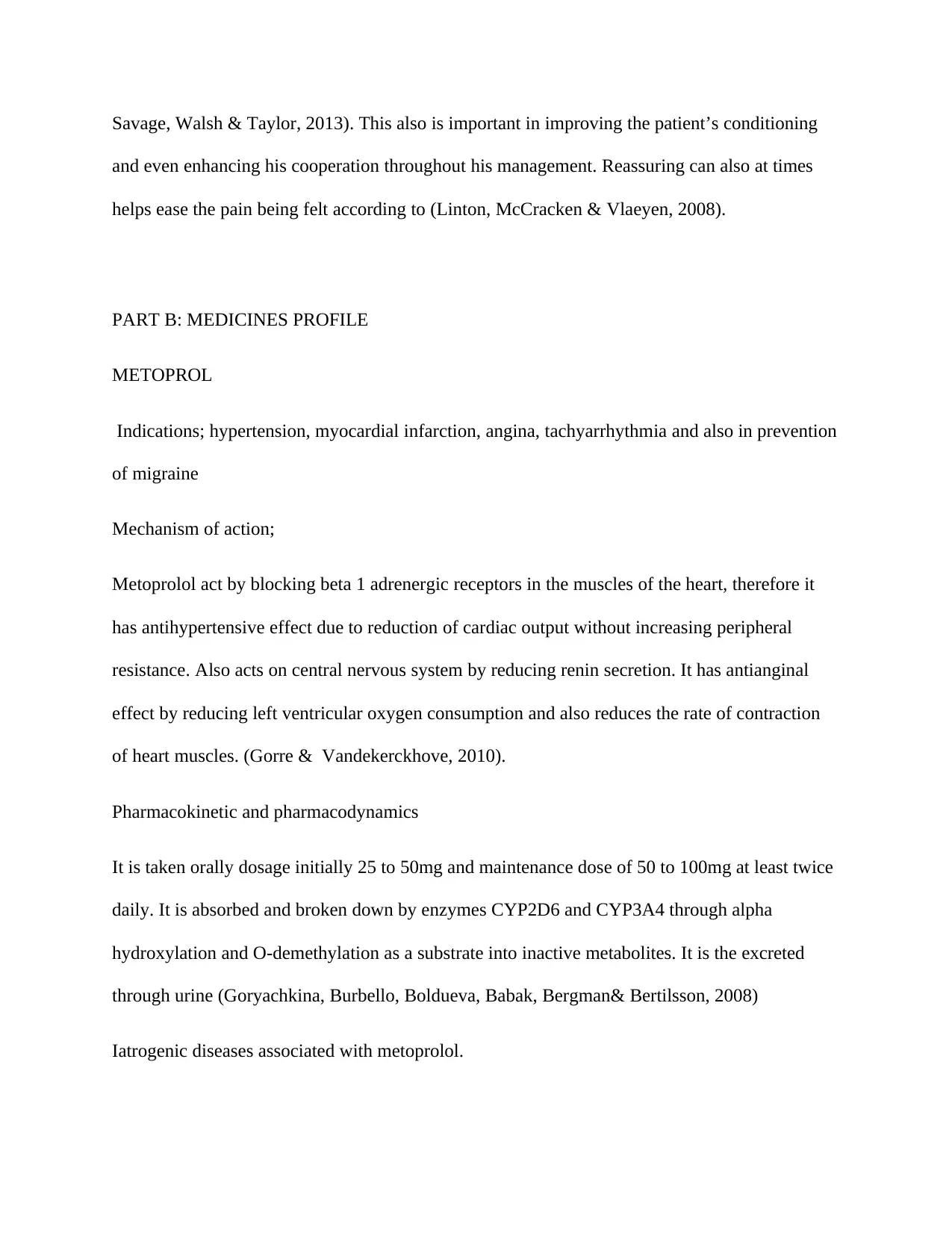
Savage, Walsh & Taylor, 2013). This also is important in improving the patient’s conditioning
and even enhancing his cooperation throughout his management. Reassuring can also at times
helps ease the pain being felt according to (Linton, McCracken & Vlaeyen, 2008).
PART B: MEDICINES PROFILE
METOPROL
Indications; hypertension, myocardial infarction, angina, tachyarrhythmia and also in prevention
of migraine
Mechanism of action;
Metoprolol act by blocking beta 1 adrenergic receptors in the muscles of the heart, therefore it
has antihypertensive effect due to reduction of cardiac output without increasing peripheral
resistance. Also acts on central nervous system by reducing renin secretion. It has antianginal
effect by reducing left ventricular oxygen consumption and also reduces the rate of contraction
of heart muscles. (Gorre & Vandekerckhove, 2010).
Pharmacokinetic and pharmacodynamics
It is taken orally dosage initially 25 to 50mg and maintenance dose of 50 to 100mg at least twice
daily. It is absorbed and broken down by enzymes CYP2D6 and CYP3A4 through alpha
hydroxylation and O-demethylation as a substrate into inactive metabolites. It is the excreted
through urine (Goryachkina, Burbello, Boldueva, Babak, Bergman& Bertilsson, 2008)
Iatrogenic diseases associated with metoprolol.
and even enhancing his cooperation throughout his management. Reassuring can also at times
helps ease the pain being felt according to (Linton, McCracken & Vlaeyen, 2008).
PART B: MEDICINES PROFILE
METOPROL
Indications; hypertension, myocardial infarction, angina, tachyarrhythmia and also in prevention
of migraine
Mechanism of action;
Metoprolol act by blocking beta 1 adrenergic receptors in the muscles of the heart, therefore it
has antihypertensive effect due to reduction of cardiac output without increasing peripheral
resistance. Also acts on central nervous system by reducing renin secretion. It has antianginal
effect by reducing left ventricular oxygen consumption and also reduces the rate of contraction
of heart muscles. (Gorre & Vandekerckhove, 2010).
Pharmacokinetic and pharmacodynamics
It is taken orally dosage initially 25 to 50mg and maintenance dose of 50 to 100mg at least twice
daily. It is absorbed and broken down by enzymes CYP2D6 and CYP3A4 through alpha
hydroxylation and O-demethylation as a substrate into inactive metabolites. It is the excreted
through urine (Goryachkina, Burbello, Boldueva, Babak, Bergman& Bertilsson, 2008)
Iatrogenic diseases associated with metoprolol.

This includes; Diaphoresis, confusion, dizziness, chest pain, sweating, unusual tiredness, noisy
breathing and irregular heartbeats.
Contraindications
It is known to worsen symptoms of heart failure in some patients such as chest pains, fatigue,
and shortness of breath, irregular heartbeats and dilated neck veins. It may also cause changes in
blood sugar levels and therefore such signs of hypoglycemia such as rapid heart rate may be
covered up. Therefore, reduce dose in patients with heart failure and diabetes.
CLOPIDOGREL
Clopidogrel is an antiplatelet agent and it is an example of Thienopyridine. It is used in
secondary prevention of stroke and myocardial infraction, non –ST- segment elevation acute
coronary syndrome (with aspirin).
MOA
It reduces platelet aggregation by irreversibly inhibiting the ADP receptors of platelets which
induces platelet aggregation.
PHARMACOKINETICS AND PHARMACODYNAMICS
It is a prodrug which when taken orally it is rapidly absorbed. Maximal platelet inhibition is 8 to
10 days after therapy is started and this effect persists for a few days after therapy is stopped. It is
less leukopenia and thrombocytopenic.
Iatrogenic diseases
breathing and irregular heartbeats.
Contraindications
It is known to worsen symptoms of heart failure in some patients such as chest pains, fatigue,
and shortness of breath, irregular heartbeats and dilated neck veins. It may also cause changes in
blood sugar levels and therefore such signs of hypoglycemia such as rapid heart rate may be
covered up. Therefore, reduce dose in patients with heart failure and diabetes.
CLOPIDOGREL
Clopidogrel is an antiplatelet agent and it is an example of Thienopyridine. It is used in
secondary prevention of stroke and myocardial infraction, non –ST- segment elevation acute
coronary syndrome (with aspirin).
MOA
It reduces platelet aggregation by irreversibly inhibiting the ADP receptors of platelets which
induces platelet aggregation.
PHARMACOKINETICS AND PHARMACODYNAMICS
It is a prodrug which when taken orally it is rapidly absorbed. Maximal platelet inhibition is 8 to
10 days after therapy is started and this effect persists for a few days after therapy is stopped. It is
less leukopenia and thrombocytopenic.
Iatrogenic diseases
⊘ This is a preview!⊘
Do you want full access?
Subscribe today to unlock all pages.

Trusted by 1+ million students worldwide
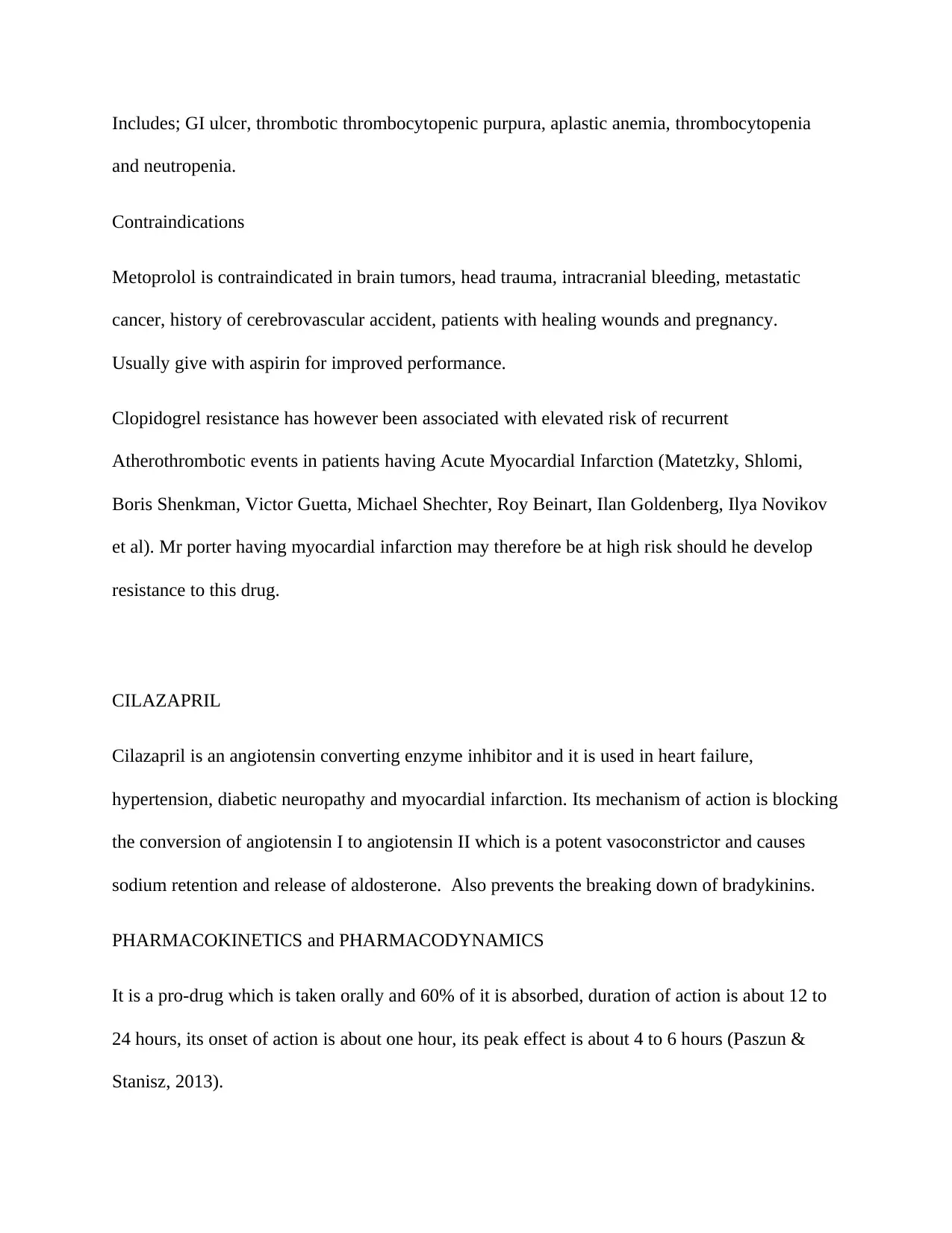
Includes; GI ulcer, thrombotic thrombocytopenic purpura, aplastic anemia, thrombocytopenia
and neutropenia.
Contraindications
Metoprolol is contraindicated in brain tumors, head trauma, intracranial bleeding, metastatic
cancer, history of cerebrovascular accident, patients with healing wounds and pregnancy.
Usually give with aspirin for improved performance.
Clopidogrel resistance has however been associated with elevated risk of recurrent
Atherothrombotic events in patients having Acute Myocardial Infarction (Matetzky, Shlomi,
Boris Shenkman, Victor Guetta, Michael Shechter, Roy Beinart, Ilan Goldenberg, Ilya Novikov
et al). Mr porter having myocardial infarction may therefore be at high risk should he develop
resistance to this drug.
CILAZAPRIL
Cilazapril is an angiotensin converting enzyme inhibitor and it is used in heart failure,
hypertension, diabetic neuropathy and myocardial infarction. Its mechanism of action is blocking
the conversion of angiotensin I to angiotensin II which is a potent vasoconstrictor and causes
sodium retention and release of aldosterone. Also prevents the breaking down of bradykinins.
PHARMACOKINETICS and PHARMACODYNAMICS
It is a pro-drug which is taken orally and 60% of it is absorbed, duration of action is about 12 to
24 hours, its onset of action is about one hour, its peak effect is about 4 to 6 hours (Paszun &
Stanisz, 2013).
and neutropenia.
Contraindications
Metoprolol is contraindicated in brain tumors, head trauma, intracranial bleeding, metastatic
cancer, history of cerebrovascular accident, patients with healing wounds and pregnancy.
Usually give with aspirin for improved performance.
Clopidogrel resistance has however been associated with elevated risk of recurrent
Atherothrombotic events in patients having Acute Myocardial Infarction (Matetzky, Shlomi,
Boris Shenkman, Victor Guetta, Michael Shechter, Roy Beinart, Ilan Goldenberg, Ilya Novikov
et al). Mr porter having myocardial infarction may therefore be at high risk should he develop
resistance to this drug.
CILAZAPRIL
Cilazapril is an angiotensin converting enzyme inhibitor and it is used in heart failure,
hypertension, diabetic neuropathy and myocardial infarction. Its mechanism of action is blocking
the conversion of angiotensin I to angiotensin II which is a potent vasoconstrictor and causes
sodium retention and release of aldosterone. Also prevents the breaking down of bradykinins.
PHARMACOKINETICS and PHARMACODYNAMICS
It is a pro-drug which is taken orally and 60% of it is absorbed, duration of action is about 12 to
24 hours, its onset of action is about one hour, its peak effect is about 4 to 6 hours (Paszun &
Stanisz, 2013).
Paraphrase This Document
Need a fresh take? Get an instant paraphrase of this document with our AI Paraphraser
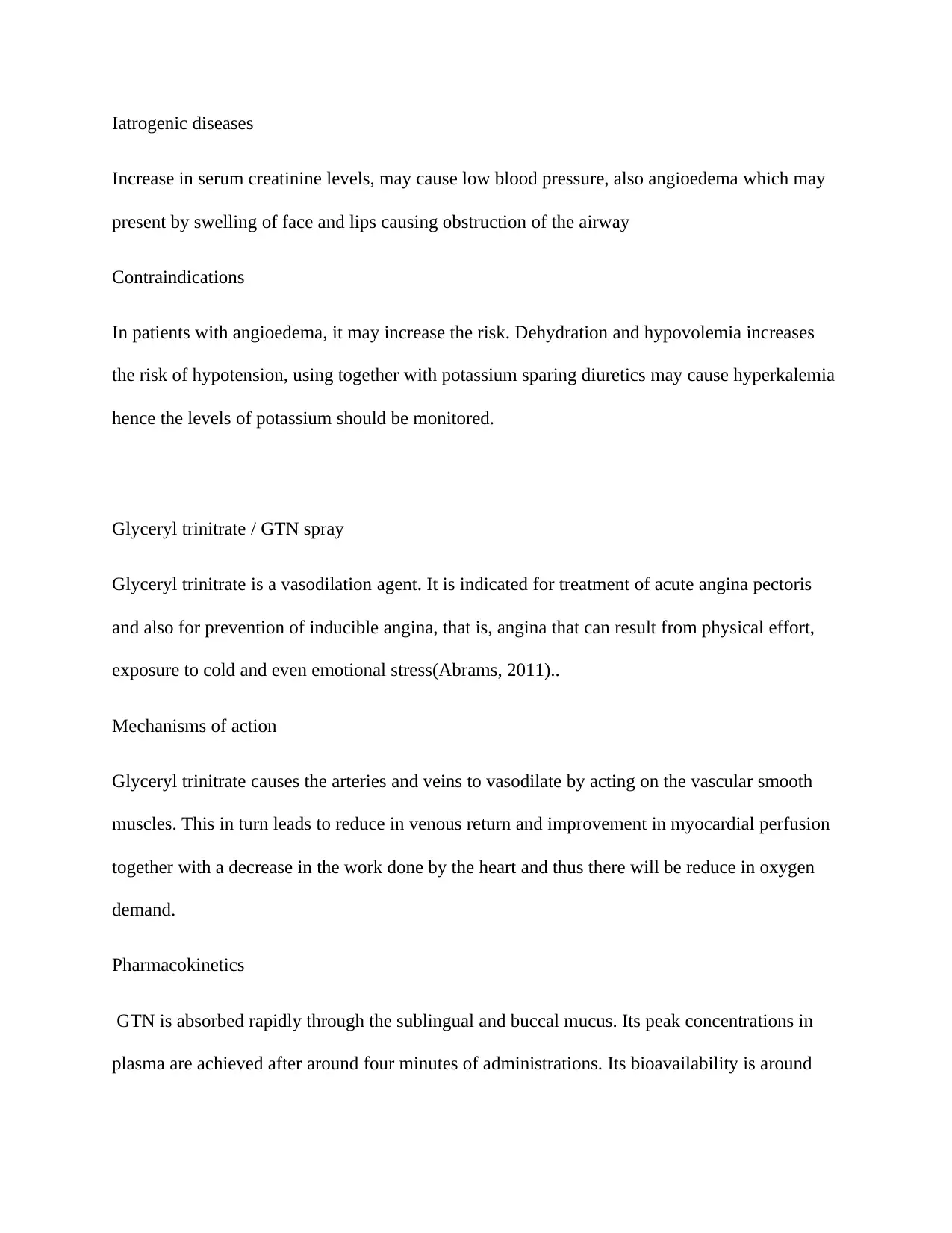
Iatrogenic diseases
Increase in serum creatinine levels, may cause low blood pressure, also angioedema which may
present by swelling of face and lips causing obstruction of the airway
Contraindications
In patients with angioedema, it may increase the risk. Dehydration and hypovolemia increases
the risk of hypotension, using together with potassium sparing diuretics may cause hyperkalemia
hence the levels of potassium should be monitored.
Glyceryl trinitrate / GTN spray
Glyceryl trinitrate is a vasodilation agent. It is indicated for treatment of acute angina pectoris
and also for prevention of inducible angina, that is, angina that can result from physical effort,
exposure to cold and even emotional stress(Abrams, 2011)..
Mechanisms of action
Glyceryl trinitrate causes the arteries and veins to vasodilate by acting on the vascular smooth
muscles. This in turn leads to reduce in venous return and improvement in myocardial perfusion
together with a decrease in the work done by the heart and thus there will be reduce in oxygen
demand.
Pharmacokinetics
GTN is absorbed rapidly through the sublingual and buccal mucus. Its peak concentrations in
plasma are achieved after around four minutes of administrations. Its bioavailability is around
Increase in serum creatinine levels, may cause low blood pressure, also angioedema which may
present by swelling of face and lips causing obstruction of the airway
Contraindications
In patients with angioedema, it may increase the risk. Dehydration and hypovolemia increases
the risk of hypotension, using together with potassium sparing diuretics may cause hyperkalemia
hence the levels of potassium should be monitored.
Glyceryl trinitrate / GTN spray
Glyceryl trinitrate is a vasodilation agent. It is indicated for treatment of acute angina pectoris
and also for prevention of inducible angina, that is, angina that can result from physical effort,
exposure to cold and even emotional stress(Abrams, 2011)..
Mechanisms of action
Glyceryl trinitrate causes the arteries and veins to vasodilate by acting on the vascular smooth
muscles. This in turn leads to reduce in venous return and improvement in myocardial perfusion
together with a decrease in the work done by the heart and thus there will be reduce in oxygen
demand.
Pharmacokinetics
GTN is absorbed rapidly through the sublingual and buccal mucus. Its peak concentrations in
plasma are achieved after around four minutes of administrations. Its bioavailability is around
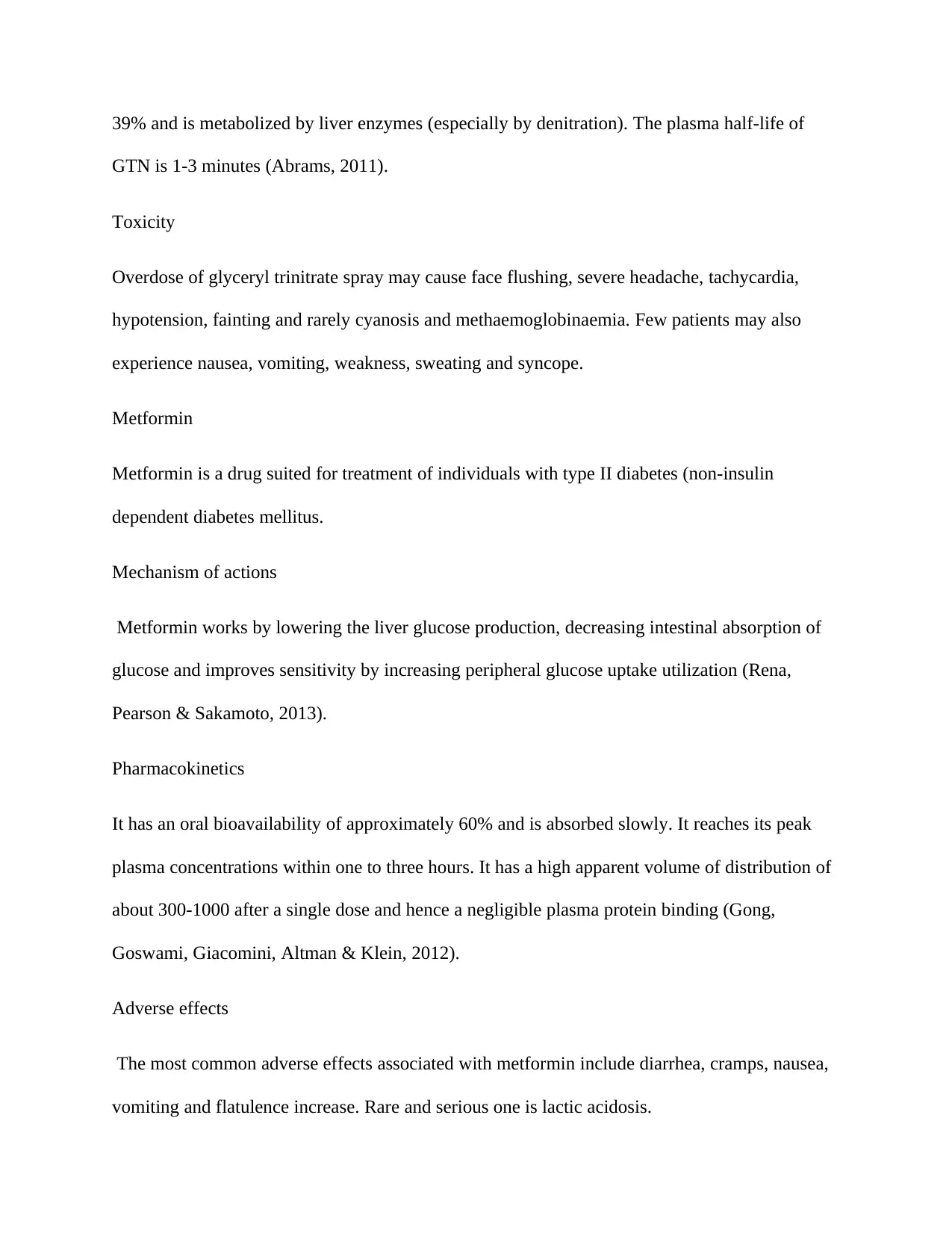
39% and is metabolized by liver enzymes (especially by denitration). The plasma half-life of
GTN is 1-3 minutes (Abrams, 2011).
Toxicity
Overdose of glyceryl trinitrate spray may cause face flushing, severe headache, tachycardia,
hypotension, fainting and rarely cyanosis and methaemoglobinaemia. Few patients may also
experience nausea, vomiting, weakness, sweating and syncope.
Metformin
Metformin is a drug suited for treatment of individuals with type II diabetes (non-insulin
dependent diabetes mellitus.
Mechanism of actions
Metformin works by lowering the liver glucose production, decreasing intestinal absorption of
glucose and improves sensitivity by increasing peripheral glucose uptake utilization (Rena,
Pearson & Sakamoto, 2013).
Pharmacokinetics
It has an oral bioavailability of approximately 60% and is absorbed slowly. It reaches its peak
plasma concentrations within one to three hours. It has a high apparent volume of distribution of
about 300-1000 after a single dose and hence a negligible plasma protein binding (Gong,
Goswami, Giacomini, Altman & Klein, 2012).
Adverse effects
The most common adverse effects associated with metformin include diarrhea, cramps, nausea,
vomiting and flatulence increase. Rare and serious one is lactic acidosis.
GTN is 1-3 minutes (Abrams, 2011).
Toxicity
Overdose of glyceryl trinitrate spray may cause face flushing, severe headache, tachycardia,
hypotension, fainting and rarely cyanosis and methaemoglobinaemia. Few patients may also
experience nausea, vomiting, weakness, sweating and syncope.
Metformin
Metformin is a drug suited for treatment of individuals with type II diabetes (non-insulin
dependent diabetes mellitus.
Mechanism of actions
Metformin works by lowering the liver glucose production, decreasing intestinal absorption of
glucose and improves sensitivity by increasing peripheral glucose uptake utilization (Rena,
Pearson & Sakamoto, 2013).
Pharmacokinetics
It has an oral bioavailability of approximately 60% and is absorbed slowly. It reaches its peak
plasma concentrations within one to three hours. It has a high apparent volume of distribution of
about 300-1000 after a single dose and hence a negligible plasma protein binding (Gong,
Goswami, Giacomini, Altman & Klein, 2012).
Adverse effects
The most common adverse effects associated with metformin include diarrhea, cramps, nausea,
vomiting and flatulence increase. Rare and serious one is lactic acidosis.
⊘ This is a preview!⊘
Do you want full access?
Subscribe today to unlock all pages.

Trusted by 1+ million students worldwide
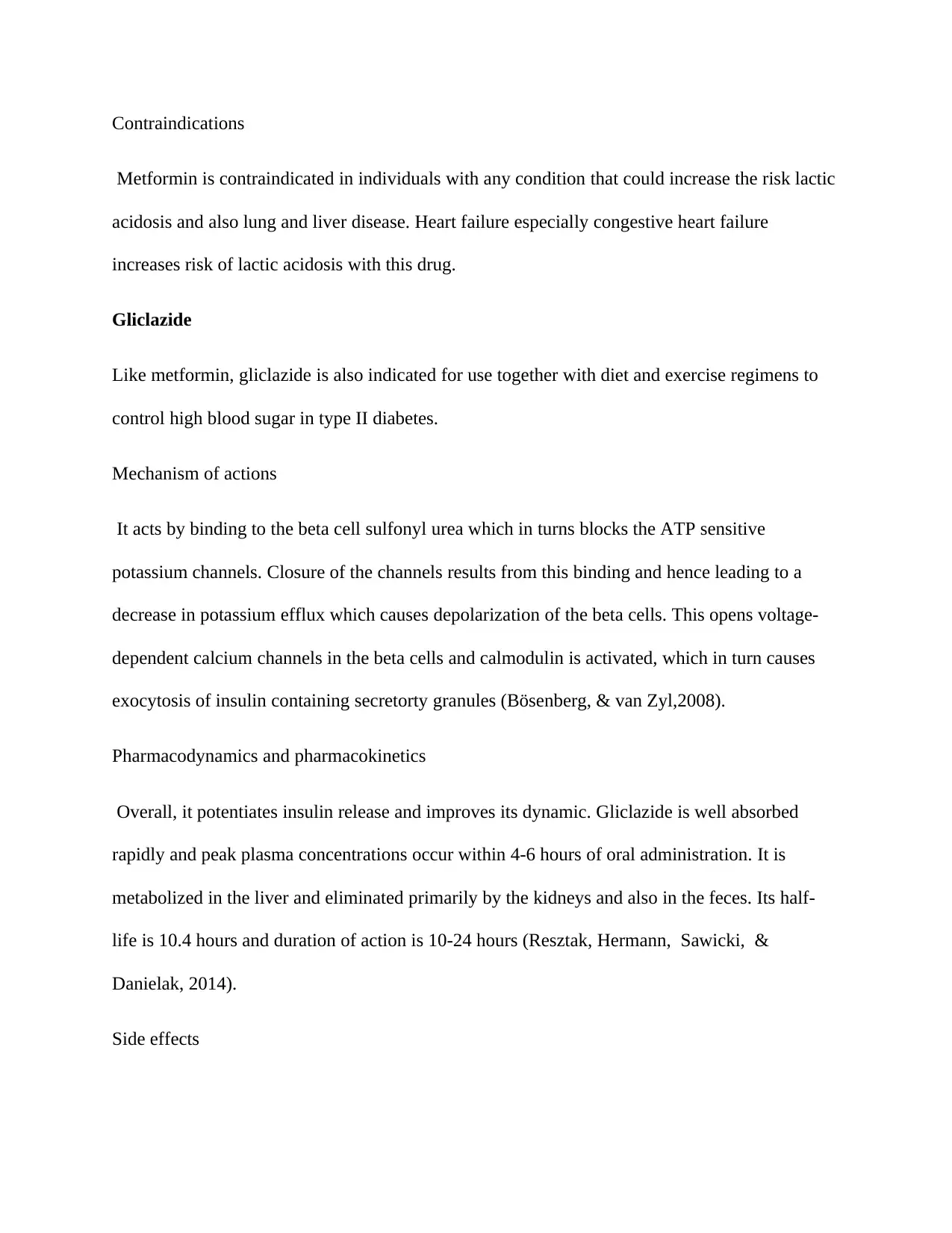
Contraindications
Metformin is contraindicated in individuals with any condition that could increase the risk lactic
acidosis and also lung and liver disease. Heart failure especially congestive heart failure
increases risk of lactic acidosis with this drug.
Gliclazide
Like metformin, gliclazide is also indicated for use together with diet and exercise regimens to
control high blood sugar in type II diabetes.
Mechanism of actions
It acts by binding to the beta cell sulfonyl urea which in turns blocks the ATP sensitive
potassium channels. Closure of the channels results from this binding and hence leading to a
decrease in potassium efflux which causes depolarization of the beta cells. This opens voltage-
dependent calcium channels in the beta cells and calmodulin is activated, which in turn causes
exocytosis of insulin containing secretorty granules (Bösenberg, & van Zyl,2008).
Pharmacodynamics and pharmacokinetics
Overall, it potentiates insulin release and improves its dynamic. Gliclazide is well absorbed
rapidly and peak plasma concentrations occur within 4-6 hours of oral administration. It is
metabolized in the liver and eliminated primarily by the kidneys and also in the feces. Its half-
life is 10.4 hours and duration of action is 10-24 hours (Resztak, Hermann, Sawicki, &
Danielak, 2014).
Side effects
Metformin is contraindicated in individuals with any condition that could increase the risk lactic
acidosis and also lung and liver disease. Heart failure especially congestive heart failure
increases risk of lactic acidosis with this drug.
Gliclazide
Like metformin, gliclazide is also indicated for use together with diet and exercise regimens to
control high blood sugar in type II diabetes.
Mechanism of actions
It acts by binding to the beta cell sulfonyl urea which in turns blocks the ATP sensitive
potassium channels. Closure of the channels results from this binding and hence leading to a
decrease in potassium efflux which causes depolarization of the beta cells. This opens voltage-
dependent calcium channels in the beta cells and calmodulin is activated, which in turn causes
exocytosis of insulin containing secretorty granules (Bösenberg, & van Zyl,2008).
Pharmacodynamics and pharmacokinetics
Overall, it potentiates insulin release and improves its dynamic. Gliclazide is well absorbed
rapidly and peak plasma concentrations occur within 4-6 hours of oral administration. It is
metabolized in the liver and eliminated primarily by the kidneys and also in the feces. Its half-
life is 10.4 hours and duration of action is 10-24 hours (Resztak, Hermann, Sawicki, &
Danielak, 2014).
Side effects
Paraphrase This Document
Need a fresh take? Get an instant paraphrase of this document with our AI Paraphraser
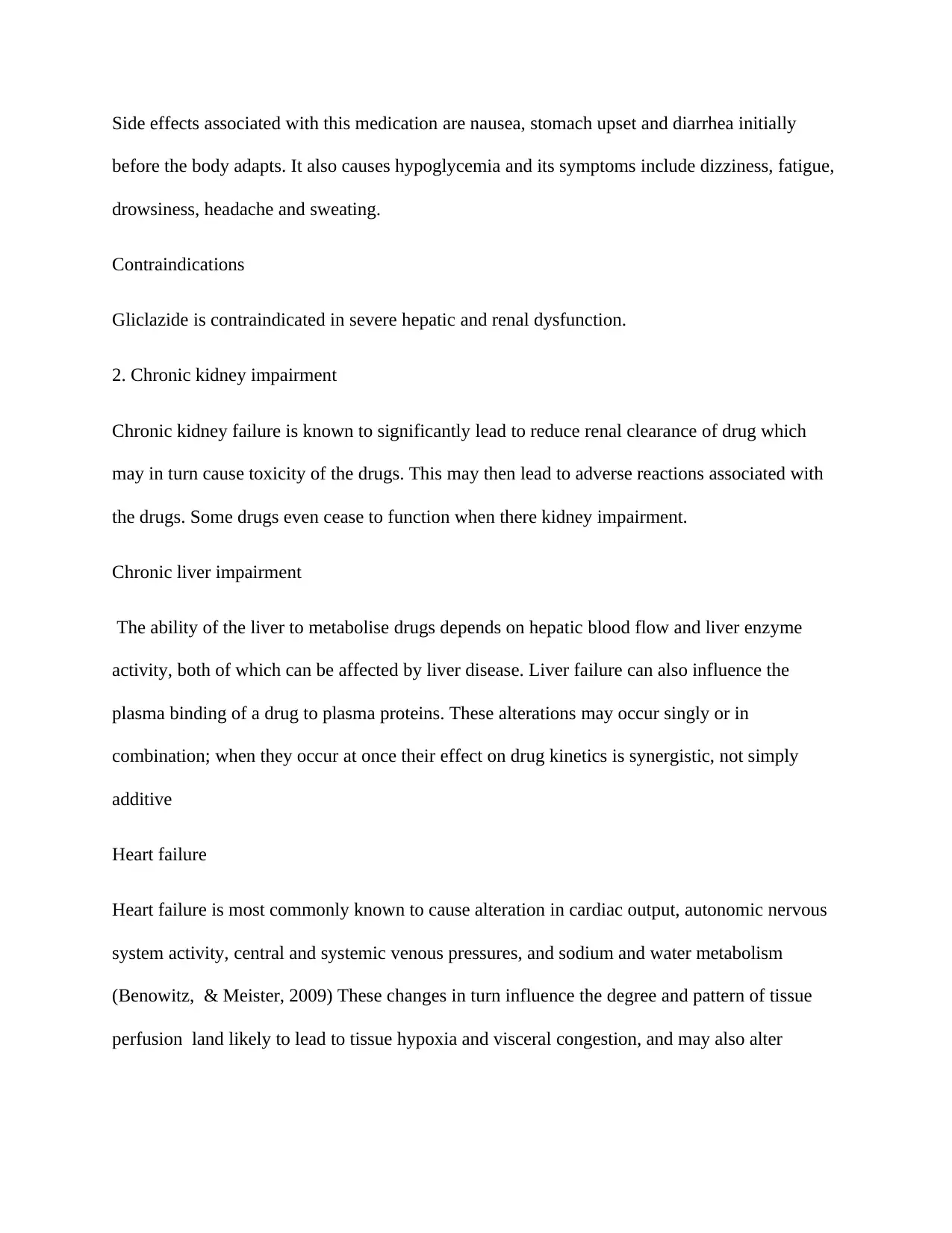
Side effects associated with this medication are nausea, stomach upset and diarrhea initially
before the body adapts. It also causes hypoglycemia and its symptoms include dizziness, fatigue,
drowsiness, headache and sweating.
Contraindications
Gliclazide is contraindicated in severe hepatic and renal dysfunction.
2. Chronic kidney impairment
Chronic kidney failure is known to significantly lead to reduce renal clearance of drug which
may in turn cause toxicity of the drugs. This may then lead to adverse reactions associated with
the drugs. Some drugs even cease to function when there kidney impairment.
Chronic liver impairment
The ability of the liver to metabolise drugs depends on hepatic blood flow and liver enzyme
activity, both of which can be affected by liver disease. Liver failure can also influence the
plasma binding of a drug to plasma proteins. These alterations may occur singly or in
combination; when they occur at once their effect on drug kinetics is synergistic, not simply
additive
Heart failure
Heart failure is most commonly known to cause alteration in cardiac output, autonomic nervous
system activity, central and systemic venous pressures, and sodium and water metabolism
(Benowitz, & Meister, 2009) These changes in turn influence the degree and pattern of tissue
perfusion land likely to lead to tissue hypoxia and visceral congestion, and may also alter
before the body adapts. It also causes hypoglycemia and its symptoms include dizziness, fatigue,
drowsiness, headache and sweating.
Contraindications
Gliclazide is contraindicated in severe hepatic and renal dysfunction.
2. Chronic kidney impairment
Chronic kidney failure is known to significantly lead to reduce renal clearance of drug which
may in turn cause toxicity of the drugs. This may then lead to adverse reactions associated with
the drugs. Some drugs even cease to function when there kidney impairment.
Chronic liver impairment
The ability of the liver to metabolise drugs depends on hepatic blood flow and liver enzyme
activity, both of which can be affected by liver disease. Liver failure can also influence the
plasma binding of a drug to plasma proteins. These alterations may occur singly or in
combination; when they occur at once their effect on drug kinetics is synergistic, not simply
additive
Heart failure
Heart failure is most commonly known to cause alteration in cardiac output, autonomic nervous
system activity, central and systemic venous pressures, and sodium and water metabolism
(Benowitz, & Meister, 2009) These changes in turn influence the degree and pattern of tissue
perfusion land likely to lead to tissue hypoxia and visceral congestion, and may also alter

gastrointestinal motility. By these mechanisms, cardiac failure likely disturbs absorption and
distribution of drugs. This will require adjustment in dosage regimen for best therapy.
PART C MEDICINES PROFILES
1. Citalopram and fluoxetine
Citalopram and fluoxetine are selective serotonin reuptake inhibitors. They specifically inhibit
serotonin reuptake into the synaptic nerve terminal hence increase serotonin in the synaptic cleft
(Böer, Noll, Cierny, Krause, Hiemke, & Knepel, 2010). They have fewer anticholinergic and
cardiotoxicity effect and commonly used to treat depression that is accompanied by agitation,
anxiety and insomnia. It inhibits various drug metabolizing enzymes therefore interact with
several drugs. Its main adverse effect is nausea, decreased libido and serotonin syndrome due to
interaction with monoamine oxidase inhibitors which leads to increased serotonin in the
synapses.
From the case study the drug is advisable for Mr Porter as it does not cause increase in cardiac
activity or muscarinic effects such as urinary retention. Hence it will help relieve the depression
that he has been diagnosed with and also improve his energy levels and how he feels about his
health. It is however advisable to try other remedies like counseling the client and maintain low
doses of this medication because he is already on several medications.
2. Erythromycin
Erythromycin is a macrolide drug that is bacterialstatic. It acts on 50s ribosomal subunit by
inhibiting bacteria protein synthesis (Anderson, Groundwater, Todd, & Worsley, 2012).
distribution of drugs. This will require adjustment in dosage regimen for best therapy.
PART C MEDICINES PROFILES
1. Citalopram and fluoxetine
Citalopram and fluoxetine are selective serotonin reuptake inhibitors. They specifically inhibit
serotonin reuptake into the synaptic nerve terminal hence increase serotonin in the synaptic cleft
(Böer, Noll, Cierny, Krause, Hiemke, & Knepel, 2010). They have fewer anticholinergic and
cardiotoxicity effect and commonly used to treat depression that is accompanied by agitation,
anxiety and insomnia. It inhibits various drug metabolizing enzymes therefore interact with
several drugs. Its main adverse effect is nausea, decreased libido and serotonin syndrome due to
interaction with monoamine oxidase inhibitors which leads to increased serotonin in the
synapses.
From the case study the drug is advisable for Mr Porter as it does not cause increase in cardiac
activity or muscarinic effects such as urinary retention. Hence it will help relieve the depression
that he has been diagnosed with and also improve his energy levels and how he feels about his
health. It is however advisable to try other remedies like counseling the client and maintain low
doses of this medication because he is already on several medications.
2. Erythromycin
Erythromycin is a macrolide drug that is bacterialstatic. It acts on 50s ribosomal subunit by
inhibiting bacteria protein synthesis (Anderson, Groundwater, Todd, & Worsley, 2012).
⊘ This is a preview!⊘
Do you want full access?
Subscribe today to unlock all pages.

Trusted by 1+ million students worldwide
1 out of 20
Related Documents
Your All-in-One AI-Powered Toolkit for Academic Success.
+13062052269
info@desklib.com
Available 24*7 on WhatsApp / Email
![[object Object]](/_next/static/media/star-bottom.7253800d.svg)
Unlock your academic potential
Copyright © 2020–2025 A2Z Services. All Rights Reserved. Developed and managed by ZUCOL.




